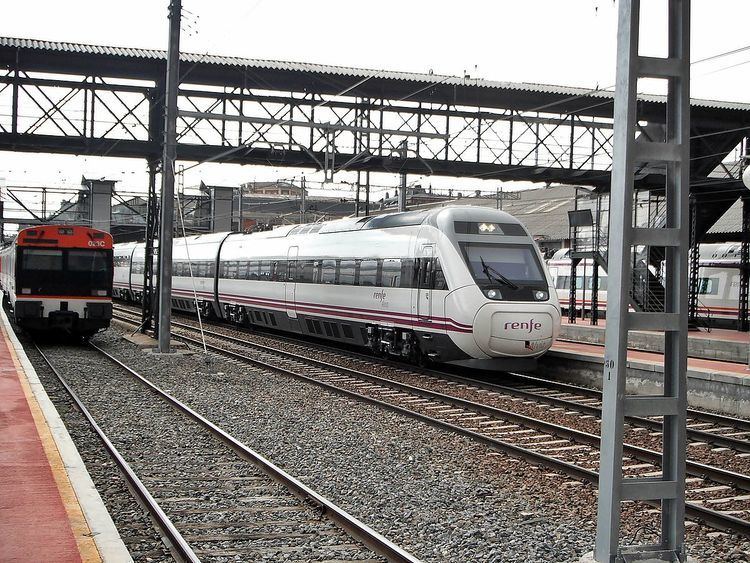Manufacturer CAF / Alstom Car body construction Aluminium | Operator(s) RENFE | |
 | ||
Constructed 2001 (order date) 12 units
2004 (order date) 45 units Capacity Class 120 : 237 (+1 reserved)
Class 121 : 280 (+2) Train length 106.230 m (348 ft 6.3 in) | ||
The RENFE Class 120 (nickname Sepia) are high-speed electric multiple units used on Alvia services in Spain.
Contents
The trainsets are dual-voltage, dual-gauge units capable of changing gauge without stopping at 30 km/h 12 units were ordered in 2001, and a further 45 units in 2004
29 units of the class RENFE Class 121 were ordered for medium-distance high-speed Avant services. The units are very similar to the Class 120 but include additional electrical equipment for redundancy (a requirement for trains using the Guadarrama Tunnel), and do not provide first class seating, raising the number of seats to 282.
Class 120
The trainsets are 4-unit multiple units capable of operating in pairs, designed for medium-distance high-speed services. The inner axle of each carriage bogie is powered by a body mounted three phase asynchronous traction motor via a cardan shaft final drive. The electrical power is regulated by IGBT devices with one converted per carriage. The bogies are of welded steel construction with primary coil springs and secondary air suspension. Tractive forces are transmitted by a drag pivot pin.
The bogies incorporate CAF's BRAVA (Bogie de Rodadura de Ancho Variable Autopropulsado) system which allows gauge-changing without stopping and operating speeds of up to 275 km/h (171 mph) The maximum axleload is 15.6 tonnes (15.4 long tons; 17.2 short tons).
The vehicles are air conditioned with one toilet per car. Passenger services include individual audio systems, and audio and visual information systems. One seat is reserved for disabled passengers, and wheelchair ramps are fitted. The driver's cab is also air conditioned, and the train is equipped with GSM-R systems.
There are 156 seats in 'standard' accommodation and 82 seats in 'first class'.
Class 121
The 121 class are built to the same design as the original 120 Class but have additional electrical equipment (duplicated for redundancy). Additionally all the seating is in [2+2] formation increasing the capacity to 282.
Class 120
The first trainset was produced in 2004 and began testing. Services on the Madrid to Barcelona line began in 2006.
The trainsets have operated on the Madrid-Pamplona-Hendaye, Madrid-Logroño, Barcelona-Vigo and Barcelona-Bilbao/Irun lines.
Class 121
The first trains entered service on the Madrid-Segovia-Valladolid line on 26 January 2009. They are currently used for the Avant services Barcelona-Lleida, A Coruña-Ourense and Zaragoza-Calatayud.
Related vehicles
The 6-car TCDD HT65000 electric multiple units ordered from CAF by the Turkish State Railways for the Istanbul-Ankara high-speed line are based upon the Class 120 design.
